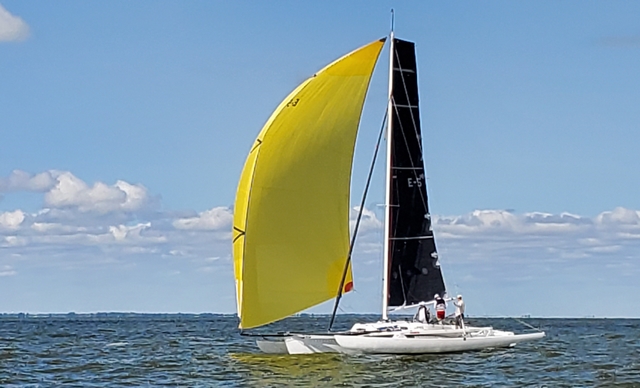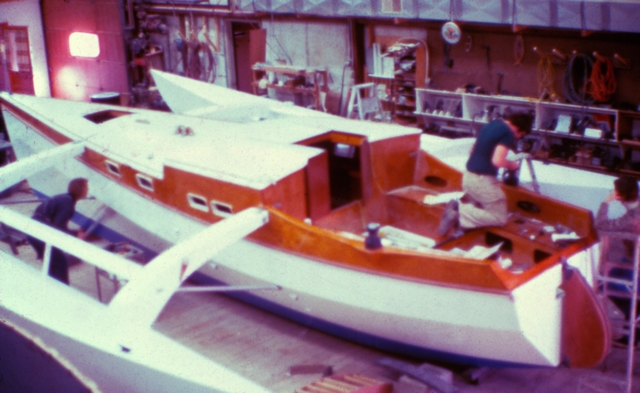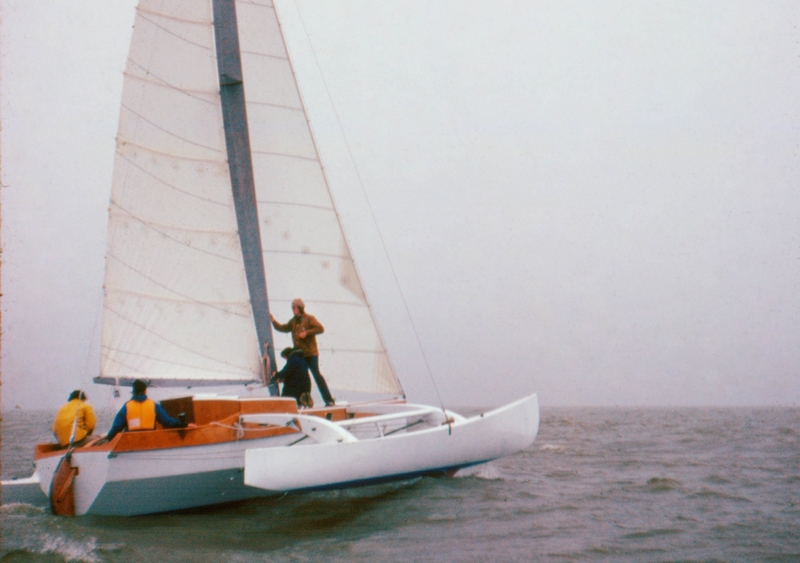
By Grace Ombry
Part 1
On Wednesday, June 20, 1979, while sailing in a qualifying race for the OSTAR (Observer Single-Handed Transatlantic Race, originally named after its first sponsor, the British Observer newspaper1), Jan Gougeon’s self-designed and built 31’ trimaran FLICKA was capsized by heavy seas in the North Atlantic. Jan survived on the overturned plywood/epoxy multihull for four days before he was rescued by a passing freighter. The following is the transcript of a phone call between Jan, his brothers Meade and Joel, as well as fellow multihull designer/sailor Mike Zuteck. Their discussion takes place on June 26, 1979, just hours after the freighter that rescued Jan from FLICKA and delivered him to dry land.
FLICKA was never recovered.
We’ve divided their lengthy discussion into two parts. In this first installment, Jan discusses FLICKA’s capsize, what it was like surviving in the upside-down trimaran.
Jan Gougeon: The wind is shifting around to the Northeast so I figure if I can make good enough time I can get across the Gulf Stream before the Northeast wind. Absolutely, if it is blowing strong out of the NE you just don’t go across the Gulf Stream. It’s that bad.
So, Wednesday morning after I got my sun sights… going there was really a hassle but on the way back, man, I had the sun sights right. I was really gung-ho on the navigation thing. I was getting close to the Gulf Stream and it was getting pretty late and the wind was picking up strength. I decided I wouldn’t sail across and instead I would hove to.
I was hove to and playing around with letting the boat lay beam to the sea. That was absolutely treacherous. A trimaran, one thing it can’t do is lay beam to the sea in any condition. It absolutely can’t do that.
Meade Gougeon: What was happening?
Jan: OK, here’s what the deal is when you lay a beam to the sea: as the wave comes it picks up the center hull and the outrigger. There is no weight on the outrigger but you are heeling 50 degrees instantly. That’s the flow of the trimaran–you can’t be beam-to-sea, you’ve got to be nose-to.
Right away I said, Huh, I can’t be beam-to cause I’m going to tip over instantly. So I put the main[sail] up and put two reefs in the main and took all the headsail off and the two reefs in the main. I tied the tiller over.
It was absolutely perfectly sitting there. And then I went down below and made something to eat and the boat almost tacked on me. So I said, boy, if it ever tacked on me, it would bear off on the other tack and go roaring off downwind and tip over on the other tack. I took the ties off the tiller and I let the tiller go stop-to-stop. It still stayed beautifully head-to-wind. It was sitting there like a duck on a pond. The motion was so comfortable and everything.
All of a sudden the sun came out so I ran down below, grabbed my sextant, got up there and took a sight. I was working out the sun site down below and all of a sudden a wave a little bigger than the rest came along and broke just as it got under the boat. I mean, it flipped me over so fast that there was no… the centrifugal force was so great that it would be like the Loop-O-Plane [carnival ride]. You’re standing on the bottom of the boat looking down at the water but you are not falling down yet, you know what I mean? In other words, the boat isn’t using its outrigger at all.
The proa* is the way to go. Absolutely, it is the way to go. I’ve got this neat boat all dreamed up already. I’ll show you when I get home. It’s self-rescuing, self-righting, won’t sink, and you can get out of it. It’s got all the answers to everything in this multihull thing.
Anyway, the trimaran–no one has figured out the answer until now. No one has said why they tip over; I absolutely know why they tip over. I can make a little model and a diagram and show you instantly why they’re absolutely treacherous if you leave them beam-to-sea. Absolutely treacherous.
Now, the next thing is, what you do right now, is lookup in the catalog for Adagio** and you order one of the hand-held VHF radios. You do it today, don’t wait until tomorrow. You do it today. You don’t buy any flares. You take all the flares you own and throw them in the Saginaw River. Take all the smoke signals and throw them in the Saginaw River. Take all that space [the flares used] and put radios there. Radios are the only thing that work.
Get this little hand-held VHF radio and build a little plywood box that it goes in. The top of the box is glued right in there with 1/16″ birch plywood and it is tied in the boat somewhere so it stays dry. All that happens now—if you ever flip over or anything—just take your jackknife and cut the top off, take out this little VHF radio and you can talk to the ships. I actually shot a flare so close I thought I was going to burn the ship up. It didn’t see me. The only flare to get are the parachute flares. If you’re going to have flares, have parachute flares.

Meade: So, how did you finally get hold of this guy?
Jan: OK, Gram [the Gougeons’ maternal grandmother, Olive Delong] is up there. You got to believe that she’s there. It’s the only way. This ship was further away than the rest and the ships sailing along. By this time, I decided that the only way anyone is ever going to see me is I’m going to build big piles of stuff on my boat. So I started dismantling the boat and putting it all on the bottom. There is stuff stuck all over: foul weather gear flying off, little shrouds. I’m working so hard building all this stuff on the bottom of the boat that I don’t–
Meade: OK, is it rough now or what?
Jan: Oh, it was blowing 24 knots. The seas are crashing right over the boat. You can’t even imagine what it’s like to build this stuff.
Joel Gougeon: How did you hang onto it?
Jan: It was just, you know, bare guts and, you know. When it’s your life, it gives you a great amount of strength.
Meade: Have you got lines strung around the boat?
Jan: No, you can’t do any of that. You’re just lucky to even hang onto the boat.
So anyway, it took me one day. When the boat tipped over the mast imploded and then came up to leeward and busted one of the trampoline boards, so I used that as a spar. It took me the better part of a day to erect that with three ropes. You can imagine what it was like. I finally got that thing up. I also took the speedo[meter] tube out and I put my man-overboard pole in the speedo tube, see, with a flag flying.
I saved three lights and I immediately took them in the cabin and took them all apart. I silicone-greased everything. I saved my silicone grease. Of all the lights, I had actually three good working lights.
Joel: Did you have to dive underwater to get in your cabin?
Jan: No. I was inside when I tipped over, see, so I had to cut my way out. I didn’t want to dive out because there was so much stuff crashing around underneath the boat I was afraid that something would stab me or something underneath there. So I cut a hole in the back bunk that I could [use to] get out onto the boat.
Joel: So you had a handy saw or something there, hey?
Jan: I had my toolbox in there. Rip open the toolbox and there’s anything you need. So I took a chisel and a winch handle on the bottom of the boat through the ¾” plywood and I cut a nice hole that I could get in and out of. Once I had that, I no longer had to actually get in the water for anything anymore as far as the lookout thing. The only time I ever got in the water was to rig stuff.
Meade: OK, are you in the Gulf Stream now, is it warm?
Jan: No, actually I’m not in the Gulf Stream but it’s still warm. I think I was in the Gulf Stream, on the fringes of it, when I tipped over. But the wind blew me out of it and then miraculously enough the wind blew me back. When they picked me up four days later I was almost in the same position as when I tipped over.
The interesting thing is that I’m tipped over, right? And they pick me up and as I get up on the bridge, there’s these two little spars moving along up ahead of us. He’s five miles away and its AZULAO***–Nick Clifton and AZULAO.
I talked to him on the telephone and stuff. He had spent a couple of days with me in Bermuda working on my self-steering and helping me to do stuff and figure out how to make it steer better and all this neat stuff. He was very understanding. He had great amounts of grief that I had lost my boat and everything.

Meade: In other words, you talked with him on the telephone?
Jan: Yeah, I talked with him on the radio.
Meade: When you were upside down?
Jan: I was on the ship.
Meade: Oh, you were on the ship. OK. Oh, I see. All right.
Jan: It was right after I got rescued. I mean, I’m still watching my boat disappear, dying slowly in the wake.
Joel: Did it sink or is it still out there floating?
Jan: Oh, it’s still floating around. The cabin–the problem is the rear window, plastic window, was leaking pretty bad. I had boards jammed up against it to slow it down, so probably by now that back compartment is flooded and it’s gone down. I had to bail it out like once in the morning and once at night, that one compartment.
Meade: What compartment is this now?
Jan: Well, where the window is in the back bunk, I had a hanging locker there. That [provided] great amounts of buoyancy to keep the stern up. But it would leak, oh, maybe 15 gallons of water a night.
Meade: Did you… Actually were you able to sleep very well during the four days?
Jan: Well, I was comfortable but I didn’t spend much time sleeping because I’d go to sleep for a few minutes and then I’d get up and watch—the only chance to see something. If you went to sleep for 15 minutes a freighter would come steaming right by. I’ll tell you the real scary thing is how many freighters there are. Unbelievable amounts of ships cruising around out there. I mean, the chances of getting run down while you’re single-handing…
Joel: How many flares did you fire? You fired every flare you had?
Jan: Yeah, I used them all up on the ships that came first and they were all gone. [I] threw the flare gun away. I had two fire extinguishers. The first one, I used that up and then I dove underneath and got the next fire extinguisher. When the ship came I was getting ready to get my propane tank. I was going to rig up, you know, a fire thing with the propane tank because I had lots of propane. Figuring I could get some of the… I had some sea boots laying around and stuff. I could hang something and get a black, smoky thing burning to attract attention.
Mike Zuteck: Well, what do you reckon it is, [the freighters] don’t have guys on watch? You mean they’re just not watching?
Jan: Yeah, they’re not watching. This one ship, the first officer was actually up and he saw me. He was further away than most of the other ships and he saw me.
Meade: So this was a big tanker that picked you up?
Jan: Pretty good size, an old one but a big one. I ate more in two days there… It’s like Grandma DeLong feeding you. They’re not happy unless you eat five times as much as you possibly can shovel down. You’re so full you’re begging to get out of there and they bring you another course. They bring you steak, fish and potatoes, and more fish, and ice cream.
Meade: You must have been pretty whipped though by the time they picked you up.
Jan: Actually, I was doing pretty good. I was pacing myself. I was concentrating on all the survival stuff and everything. I mean, I had the boat. Once I’d gotten the hole in the boat I was in danger if the wind shifted. The rig was acting as a sea anchor, keeping one side of the boat beam-to the seas. If the boat were all of a sudden to drift around somehow, water would be coming in the hole that I cut to get out. So I built a shutter for it that I could open up during the day to ventilate the cabin. The first day, of course, I got everything soaking wet back there getting in and out of there and stuff.
Meade: In other words, your mast was kind of dragging on the shrouds out there?
Jan: Yeah, right. I cut the one shroud loose so that the thing would get far enough away from the boat not to bang and crash.
Meade: Yeah, right.
Jan: After the first couple of days, the mainsail was gone, but the headsail was still streaming out there with the backstay to hold [the mast] at the right angle to where the boat drifted, about perfectly. I saved all my money, and passport, and travellers checks, and everything. I’ve got everything, all my papers, my wallet, keys, all that stuff. I’ve still got them, miraculously enough.
I decided my next boat not only has to be self-rescuing and self-righting and go fast, but it has to be trailed behind my Honda. So the displacement of the boat with no food or crew has got to be about 600 pounds. Wait until you see this thing I dreamed up.
Joel: When did you get off the ship? Just a few minutes ago?
Jan: Oh, it was about twelve o’clock today. But I was going through Customs and Immigration and they might–they still have the Search and Rescue [alert] from New York. It’s got some urgent message for me but I haven’t been able to actually get the message yet. So there is the slight possibility that I might get my boat back but it’s about a thousand to one odds.
Joel: They didn’t have a boom or anything so they could haul aboard any of your other stuff? Sextants and all that?
Jan: No, they couldn’t. They had to come and get me in a lifeboat. It was too rough, you know.
Joel: So you lost everything besides your wallet?
Jan: I saved my sextant and I saved [now retired GBI tech advisor] Jim Derck’s compass and his foul weather gear.
Right. The most tragic and the most heartbreaking thing though is to stand on the bridge of a freighter and watch your beloved piece of work drift away behind you and know that pretty soon it’s going to be sunk and gone and all that.
Editor’s Note: In part II, Jan goes on to discuss the failure of his EPIRB unit, what he learned from surviving FLICKA’s capsize, and his conviction that all multihulls should be self-rescuing.
*Proa—a boat with a single outrigger/ama.
** Adagio—Meade’s 35′ trimaran, designed and built by Meade and Jan Gougeon in 1969. It is still competitively racing on the Great Lakes.
***AZULAO—In 1977, Nick Clifton capsized his trimaran AZULAO and drifted in the Atlantic Ocean in a life raft for three days before being picked up by a freighter. His boat eventually washed ashore in England. It’s unclear whether Jan is referencing the AZULAO that had previously capsized, or Clifton’s later Dick Newick-designed AZULAO II.
1 This correction from “Original” to “Observer” was pointed out to us by alert reader Ed Lawler. Thanks Ed!





